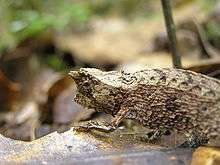Brookesiinae
| Brookesiinae | |
|---|---|
 | |
| Brookesia | |
| Scientific classification | |
| Kingdom: | Animalia |
| Phylum: | Chordata |
| Class: | Reptilia |
| Order: | Squamata |
| Suborder: | Lacertilia |
| Family: | Chamaeleonidae |
| Subfamily: | Brookesiinae Klaver & Böhme, 1986 |
The Family Chamaeleonidae was divided into two subfamilies, Brookesiinae and Chamaeleoninae, by Klaver and Böhme in 1986.[1] Under this classification, Brookesiinae included the genera Brookesia and Rhampholeon, as well as the genera later split off from them (Palleon and Rieppeleon). The Brookesiinae are small, often brown in colour, and occur in central Africa and Madagascar. They have terrestrial habits, or may be found in the lower levels of shrubs. Since its erection in 1986, however, the validity of this subfamily designation has been the subject of much debate,[2] although most phylogenetic studies support the notion that the pygmy chameleons of the subfamily Brookesiinae are not a monophyletic group.[3][4][5][6] While some authorities have previously preferred to use the subfamilial classification on the basis of the absence of evidence principal,[2] these authorities later abandoned this subfamilial division, no longer recognizing any subfamilies with the family Chamaeleonidae.[7] In 2015, however, Glaw reworked the subfamilial division by placing only the genera Brookesia and Palleon within the Brookesiinae subfamily, with all other genera being placed in Chamaeleoninae.[8]
Classification
The two genera currently included in the subfamily are:
Subfamily Brookesiinae
Footnotes
- ↑ Klaver, C. & Böhme, W. (1986). "Phylogeny and classification of the Chamaeleonidae (Sauria) with special reference to hemipenis morphology". Bonner Zoologische Monographien. 22: 1–64.
- 1 2 Tilbury, Colin (2010). Chameleons of Africa, An Atlas including the chameleons of Europe, the Middle East and Asia. Frankfurt: Edition Chimaira.
- ↑ Townsend, T. & Larson, A. (2002). "Molecular phylogenetics and mitochondrial genomic evolution in the Chamaeleonidae (Reptilia, Squamata)". Molecular Phylogenetics and Evolution. 23: 22–36. doi:10.1006/mpev.2001.1076. PMID 12182400.
- ↑ Raxworthy, C. J., Forstner, M. R. J. & Nussbaum, R. A. (2002). "Chameleon radiation by oceanic dispersal". Nature. 415: 784–787. doi:10.1038/415784a. PMID 11845207.
- ↑ Townsend, T. M., Tolley, K. A., Glaw, F., Böhme, W. & Vences, M. (2011). "Eastward from Africa: Palaeocurrent-mediated chameleon dispersal to the Seychelles islands". Biological Letters. 7: 225–228. doi:10.1098/rsbl.2010.0701.
- ↑ Tolley, K. A., Townsend, T. M. & Vences, M. (2013). "Large-scale phylogeny of chameleons suggests African origins and Eocene diversification". Proceedings of the Royal Society Part B. 280: 20130184. doi:10.1098/rspb.2013.0184.
- ↑ Tilbury, Colin (2014). "Overview of the Systematics of the Chamaeleonidae". In Tolley, Krystal A.; Herrel, Anthony. The Biology of Chameleons. Berkeley: University of California Press. pp. 151–174. ISBN 9780520276055.
- ↑ Glaw, F. (2015). "Taxonomic checklist of chameleons (Squamata: Chamaeleonidae)". Vertebrate Zoology. 65 (2): 167–246.